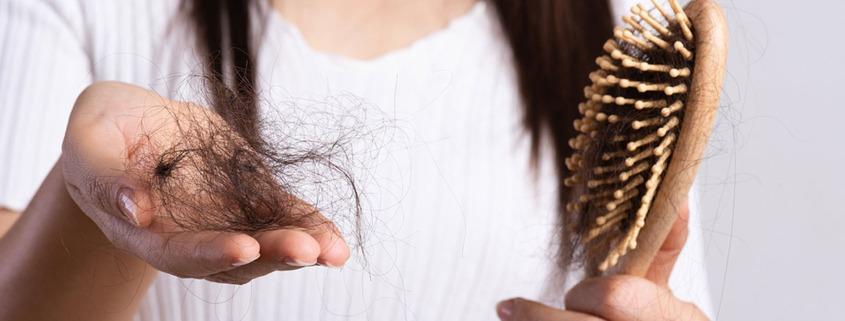What is hair loss?
Hair loss also known as alopecia can affect just your scalp or body. It can be temporary or permanent. It can be the result of heredity, hormonal changes, medical conditions or a normal part of aging. It is seen in both men and women.
What is normal?
The average adult head has about 100,000 to 150,000 hairs. A loss of upto 100 hair a day is normal. So, finding a few stray hairs on your hairbrush is not necessarily cause for alarm.
At any one time, about 90% of the hair on a person’s scalp is growing. Each follicle has its own life cycle that can be influenced by age, disease, and a wide variety of other factors.
This life cycle is divided into three phases:
- Anagen — active hair growth that generally lasts between two to eight years
- Catagen — transitional hair growth that lasts two to three weeks
- Telogen — resting phase that lasts about two to three months; at the end of the resting phase the hair is shed and a new hair replaces it and the growing cycle starts again.
Signs and symptoms of hair loss?
Gradual thinning on top of head. This is the most common type of hair loss, affecting people as they age. In men, hair often begins to recede at the hairline on the forehead. Women typically have a broadening of the part in their hair.
Sudden loosening of hair. An illness, child birth or stress or sudden shock can cause hair to suddenly start to fallout. Handfuls of hair may come out when combing or washing your hair or even after gentle tugging. This type of hair loss usually causes overall hair thinning but is temporary.
Circular or patchy bald spots. Some people lose hair in circular or patchy bald spots on the scalp, beard or eyebrows. Your skin may become itchy or painful before the hair falls out. It could be infectious or non-infectious.
Diffuse hair loss: Nutritional deficiencies and medical conditions like hypothyroidism can lead to hair loss. Certain blood tests need to be done to diagnose them and treat the underlying cause.
Full-body hair loss. Some conditions and medical treatments, such as chemotherapy for cancer, can result in the loss of hair all over your body. The hair usually grows back.
Hair loss with scarring: Diseases like lichen planopilaris, Lupus erythematous, frontal fibrosing alopecia, untreated infections can lead to permanent hairloss.
Hair loss is one of the most common disorders that dermatologists diagnose and treat.
Causes of hair loss:
- Hereditary hair loss also known as male/female pattern hair loss or Androgenetic alopecia:
It means that you’ve inherited genes that cause your hair follicles to shrink and eventually stop growing hair. Shrinking can begin as early as your teens, but it usually starts later in life. In women, the first noticeable sign of hereditary hair loss is usually overall thinning or a widening part. When a man has hereditary hair loss, the first sign is often a receding hairline or bald spot at the top of his head. - Alopecia areata:
Alopecia areata is an autoimmune disease. It means that it develops when the body’s immune system attacks hair follicles/roots causing hair loss. You can lose hair anywhere on your body, including your scalp, eyelashes or eyebrows. - Cancer treatment
If you receive chemotherapy or have radiation treatment to your head or neck, you may lose all (or most of) your hair within a few weeks of starting treatment. - After Childbirth, illness, or other stressors
A few months after giving birth, recovering from an illness, or having an operation, you may notice a lot more hairs in your brush. This can also happen after a stressful time in your life, such as a divorce or death of a loved one. - Hair care
If you color, perm, or relax your hair, you could be damaging your hair. Over time, this damage can lead to hair loss. - Hairstyle pulls on your scalp
If you often wear your hair tightly pulled back, the continual pulling can lead to permanent hair loss. The medical name for this condition is traction alopecia. - Hormonal imbalance
Hormonal imbalance like hypothyroidism, Polycystic ovarian disease (PCOD) lead to hairfall and can be taken care by addressing the underlying health issues. - Scalp infection:
Bacterial and fungal infection can lead to inflamed areas on your scalp and hairloss. - Medication:
Certain medicines can lead to hair loss - Pulling your hair
Some people pull on their hair, often to relieve stress. They may be unaware that they’re pulling their hair. The medical term for this is trichotillomania. - Scarring alopecia
This condition develops when inflammation destroys hair follicles. Once destroyed, a hair follicle cannot grow hair. Diverse conditions can cause this. The medical name for this group of conditions is cicatricial alopecia. - Nutritional deficiencies:
Like low iron, Vit B12, Vit D and other deficiencies can lead to hair and is completely reversible.
Do I need to see a dermatologist about hair loss?
Dermatologists specialize in treating the skin, hair, and nails. They have the expertise and tools to help them get to the root cause of a person’s hair loss.
The sooner you find the cause, the better your outcome. The less hair you lose, the more successful treatment (or prevention) tends to be.

